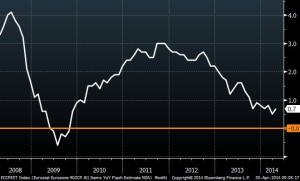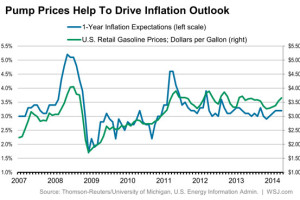Greeks, including Delta, Gamma, Theta, Vega and Rho, measure the different factors that affect the price of an option contract. They are calculated using a theoretical options pricing model (see How much is an option worth?).
Since there are a variety of market factors that can affect the price of an option in some way, assuming all other factors remain unchanged, we can use these pricing models to calculate the Greeks and determine the impact of each factor when its value changes. For example, if we know that an option typically moves less than the underlying stock, we can use Delta to determine how much it is expected to move when the stock moves $1. If we know that an option loses value over time, we can use Theta to approximate how much value it loses each day.
Following are Greek definitions:
Delta: The hedge ratio
Delta measures how much an option’s price is expected to change per $1 change in the price of the underlying security or index. For example, a Delta of 0.40 means that the option’s price will theoretically move $0.40 for every $1 move in the price of the underlying stock or index.
Call options
- Have a positive Delta that can range from zero to 1.00.
- At-the-money options usually have a Delta near .50.
- The Delta will increase (and approach 1.00) as the option gets deeper in the money.
- The Delta of in-the-money call options will get closer to 1.00 as expiration approaches.
- The Delta of out-of-the-money call options will get closer to zero as expiration approaches.
Put options
- Have a negative Delta that can range from zero to -1.00.
- At-the-money options usually have a Delta near -.50.
- The Delta will decrease (and approach -1.00) as the option gets deeper in the money.
- The Delta of in-the-money put options will get closer to -1.00 as expiration approaches.
- The Delta of out-of-the-money put options will get closer to zero as expiration approaches.
You also might think of Delta, as the percent chance (or probability) that a given option will expire in the money.
- For example, a Delta of 0.40 means the option has about a 40% chance of being in the money at expiration. This doesn’t mean your trade will be profitable. That of course, depends on the price at which you bought or sold the option.
You also might think of Delta, as the number of shares of the underlying stock, the option behaves like.
- A Delta of 0.40 also means that given a $1 move in the underlying stock, the option will likely gain or lose about the same amount of money as 40 shares of the stock.
Gamma: the rate of change of Delta
Gamma measures the rate of change in an option’s Delta per $1 change in the price of the underlying stock. Since a Delta is only good for a given moment in time, Gamma tells you how much the option’s Delta should change as the price of the underlying stock or index increases or decreases. If you remember high school physics class, you can think of Delta as speed and Gamma as acceleration.
The relationship between Delta and Gamma:
- Delta is only accurate at a certain price and time. In the Delta example above, once the stock has moved $1 and the option has subsequently moved $.40, the Delta is no longer 0.40.
- As we stated, this $1 move would cause a call option to be deeper in the money, and therefore the Delta will move closer to 1.00. Let’s assume the Delta is now 0.55.
- This change in Delta from 0.40 to 0.55 is 0.15—this is the option’s Gamma.
- Because Delta can’t exceed 1.00, Gamma decreases as an option gets further in the money and Delta approaches 1.00.
Theta: time decay
Theta measures the change in the price of an option for a one-day decrease in its time to expiration. Simply put, Theta tells you how much the price of an option should decrease as the option nears expiration.
- Since options lose value as expiration approaches, Theta estimates how much value the option will lose, each day, if all other factors remain the same.
- Because time-value erosion is not linear, Theta of at-the-money (ATM), just slightly out-of-the-money and in-the-money (ITM) options generally increases as expiration approaches, while Theta of far out-of-the-money (OOTM) options generally decreases as expiration approaches.
Source: Schwab Center for Financial Research.
Vega: sensitivity to volatility
Vega measures the rate of change in an option’s price per 1% change in the implied volatility of the underlying stock. While Vega is not a real Greek letter, it is intended to tell you how much an option’s price should move when the volatility of the underlying security or index increases or decreases.
More about Vega:
- Vega measures how the implied volatility of a stock affects the price of the options on that stock.
- Volatility is one of the most important factors affecting the value of options.
- Neglecting Vega can cause you to “overpay” when buying options. All other factors being equal, when determining strategy, consider buying options when Vega is below “normal” levels and selling options when Vega is above “normal” levels. One way to determine this is to compare the historical volatility to the implied volatility. Chart studies for both of these values exist within StreetSmart Edge®.
- A drop in Vega will typically cause both calls and puts to lose value.
- An increase in Vega will typically cause both calls and puts to gain value.
Rho: sensitivity to interest rates
Rho measures the expected change in an option’s price per 1% change in interest rates. It tells you how much the price of an option should rise or fall if the “risk-free” (U.S. Treasury-bill)* interest rate increases or decreases.
More about Rho:
- As interest rates increase, the value of call options will generally increase.
- As interest rates increase, the value of put options will usually decrease.
- For these reasons, call options have positive Rho and put options have negative Rho.
- Rho is generally not a huge factor in the price of an option, but should be considered if prevailing interest rates are expected to change, such as just before a Federal Open Market Committee (FOMC) meeting.
- Long-Term Equity AnticiPation Securities® (LEAPS®) options are far more sensitive to changes in interest rates than are shorter-term options.
You can see the effects of Rho by considering a hypothetical stock that’s trading exactly at its strike price.
- If the stock is trading at $25, the 25 calls and the 25 puts would both be exactly at the money.
- You might see the calls trading at a price of $0.60, while the puts may trade at a price of $0.50.
- When interest rates are low, the difference will be relatively small.
- As interest rates increase, this difference between puts and calls whose strikes are equidistant from the underlying stock will get wider.
What can option Greeks do for you?
Armed with Greeks, an options trader can make more informed decisions about which options to trade, and when to trade them. Consider some of the things Greeks may help you do:
- Gauge the likelihood that an option you’re considering will expire in the money (Delta).
- Estimate how much the Delta will change when the stock price changes (Gamma).
- Get a feel for how much value your option might lose each day as it approaches expiration (Theta).
- Understand how sensitive an option might be to large price swings in the underlying stock (Vega).
- Simulate the effect of interest rate changes on an option (Rho).
Implied volatility: like a Greek
Though not actually a Greek, implied volatility is closely related. The implied volatility of an option is the theoretical volatility based on the option’s quoted price. The implied volatility of a stock is an estimate of how its price may change going forward. In other words, implied volatility is the estimated volatility of a stock that is implied by the prices of the options on that stock. Key points to remember:
- Implied volatility is derived using a theoretical pricing model and solving for volatility.
- Since volatility is the only component of the pricing model that is estimated (based on historical volatility), it’s possible to calculate the current volatility estimate the options market maker is using.
- Higher-than-normal implied volatilities are usually more favorable for options sellers, while lower-than-normal implied volatilities are more favorable for option buyers because volatility often reverts back to its mean over time.
- To an options trader, solving for implied volatility is generally more useful than calculating the theoretical price, since it’s difficult for most traders to estimate future volatility.
- Implied volatility is usually not consistent for all options of a particular security or index and will generally be lowest for at-the-money and near-the-money options.
Since it’s difficult on your own to estimate how volatile a stock really is, you can watch the implied volatility to know what volatility assumption the market makers are using in determining their quoted bid and ask prices.
How much is an option worth?
It seems like a fairly simple question, but the answer is complex. There’s a lot of number crunching that goes into determining an option’s price. Most options market makers use some variation of what’s known as a theoretical options pricing model.
By far, the best-known pricing model is the Black-Scholes model. After more than three years of research, university scholars Fisher Black and Myron Scholes published their model back in 1973, only a month after the Chicago Board Options Exchange (CBOE) began trading standardized options. While options traders initially scoffed at their ideas, this breakthrough was so ahead of its time that it took a quarter century to be fully appreciated. Though Fisher Black died in 1975, Myron Scholes along with Robert Merton, a colleague of theirs who helped improve the formula, were awarded the Nobel Prize in Economics for their model in 1997.
While the original model was groundbreaking, it had a few limitations because it was designed for European style options and it did not take into consideration, the dividend yield of the underlying stock. There are now many variations, which have improved upon the original model, including:
- Cox-Ross-Rubenstein binomial (1979): for American style options including dividend yield. This is probably the most widely used model today because it’s very accurate with American-style equity options.
- Barone-Adesi-Whaley: for American style options including dividend yield.
- Black-Scholes-Merton (our default model): for American style options including dividend yield.
Each model estimates what an option is worth by considering the following six factors:
- Current underlying stock price (higher value increases calls and decreases puts).
- Strike price of the option (higher value decreases calls and increases puts).
- Stock price volatility (estimated by the annual standard deviation, higher value increases calls and puts).
- Risk-free interest rate (higher value increases calls and decreases puts).
- Time to expiration (as a percent of a year, higher value increases calls and puts).
- Underlying stock-dividend yield (higher value decreases calls and increases puts).
(Source: Original article from Schwab was repurposed for this Blog post)





